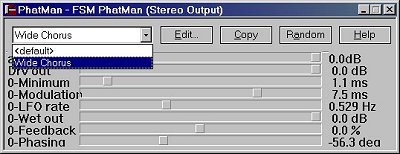
An effect is something that modifies a sound. Buzz offers a huge variety of effects and the flexibility to daisy-chain effects into chains whose effects as a whole are unlimited.
Effects are difficult to classify. Whilst some increase the volume of the sound, others change the 'fullness' or resonance of the sound, still others add echo, some change the pitch of a sound, others flange or distort it.
Effect generators can be added in the gap between any 2 machines (generators or effects). The combined effects of generators can be complex, can involve both volume and stereo engineering.

Most Buzz effects contain presets - these are collections of settings that perform a named effect. In the above effect parameter dialogue a preset is being selected.
Effects are really important to the overall feel of a Buzz song. They add timbre, texture and colour to the sound, as well as effecting it's tone and position in the stereo picture. Some effects are static - that is you set them and can forget them. Others are best if they are adjusted during the song.
To program changes to an effect during the song, you can create patterns for the effect machines as well - changing the numerical parameters over time. These effect patterns are then plugged into the sequence editor like generator patterns. The Buzz interface will allow you to generate patterns for all machines in your apparatus. Your master machine can also be programmed to perform fade-outs/fade-ins of particular machines and of the grand-master volume to control introdictions and conclusions of songs.

Effect machines can be daisychained to each other to combine what they do, they can be cross-wired and short-circuited also to add to the complexity of the path the sound must take before it gets to the master.
Buzz will prevent you from creating a feedback (where the sound gets back to a machine it has already been through) - this is a good thing, as few (apart from Hendrix) were able to make feedback sound acceptable. Feedback-like distortion is achieved in other ways, by tweaking parameters inside effect machines.
Go on to learn more about Copyright....
pwhitehouse@optushome.com.au
Buzz © Jeskola
![]()